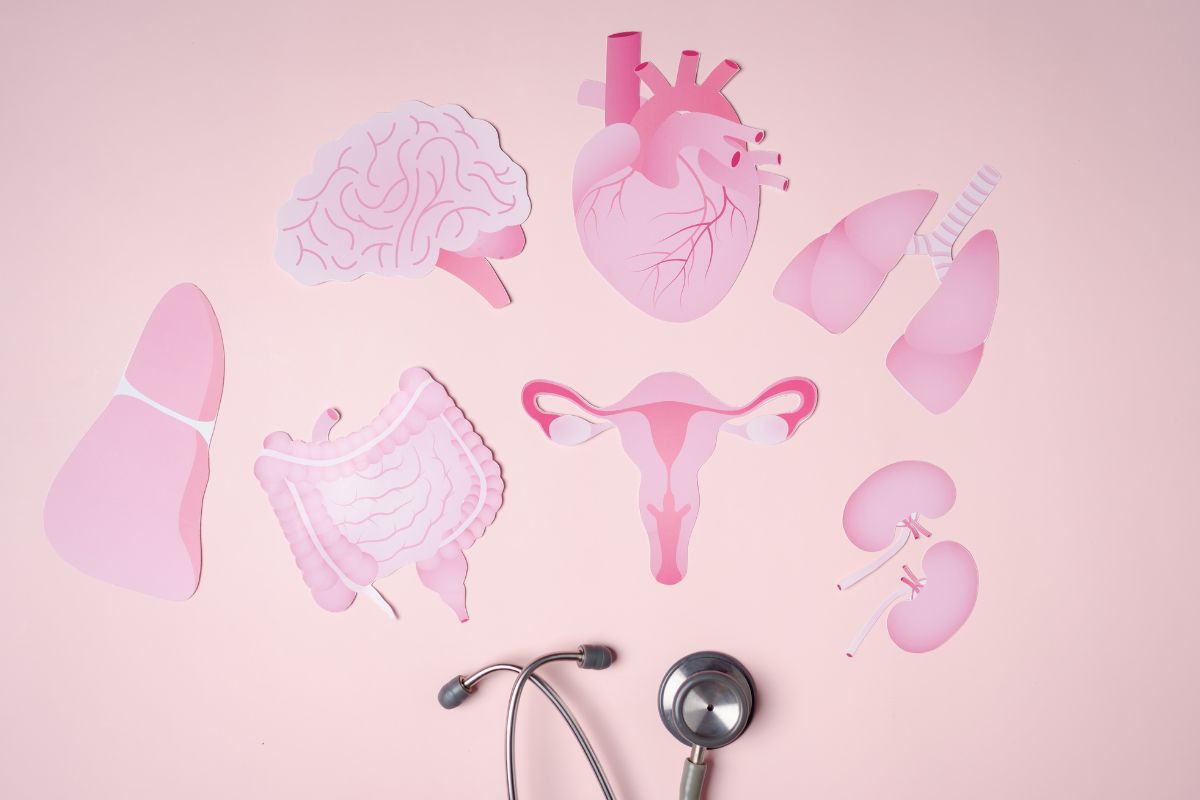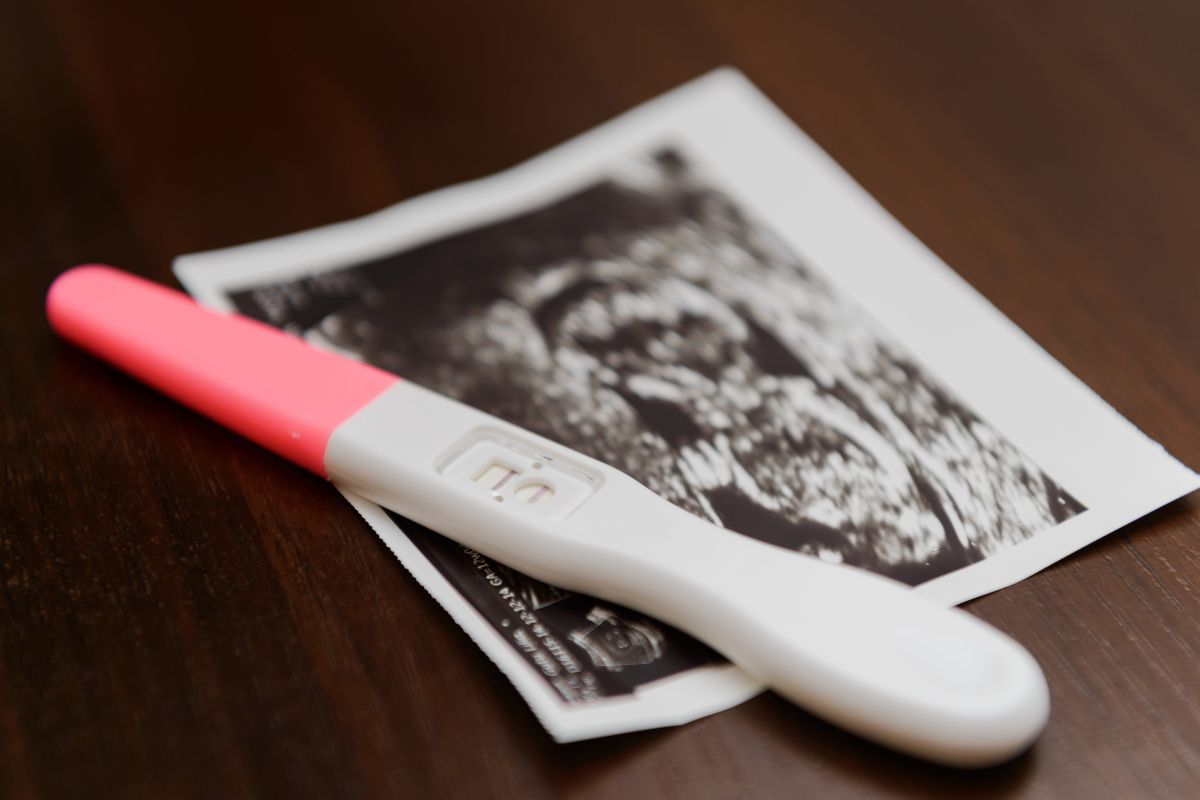Bleeding outside of your normal menstrual cycle can be a cause for worry, and if it happens to you there may be a million things running through your mind. Are you pregnant, is it cancer, or do you have an STI?

In truth, it could be any of those things, but chances are you’re just experiencing something that a lot of other women experience: mid cycle bleeding.
This is often called ovulation bleeding as mid cycle is when ovulation occurs.
So we’re going to look at ovulation bleeding and spotting and ask, “Is it normal mid cycle?” We’ll discuss ovulation, and what ovulation bleeding looks like.
We’ll also run through the conditions that can cause this spotting to happen and consider what you can do about it.
Explaining Ovulation
Before looking at ovulation bleeding and spotting it’s a good idea to be completely clear about what ovulation is. That way you can be informed about what to expect during your cycle and recognize what is normal and what isn’t.
While many women may have a good understanding of the process others may be too embarrassed to admit they don’t know what ovulation means or only have a vague idea.
Understanding ovulation is vital if you want to get pregnant as it will have an impact on your efforts. It can lessen the stress if you’re failing to get pregnant as it may be all about your timing.
Ovulation takes place when one of your ovaries releases a mature egg. The egg travels down a fallopian tube towards your uterus. If it encounters sperm, the egg may be fertilized.
The walls of your uterus thicken in anticipation of receiving a fertilized egg in order to nourish it. If the egg is not fertilized, then the uterine lining and the unfertilized egg are shed through your vagina. This is your period.
Ovulation happens around two weeks before your period and occurs every month for most women.
What Does Ovulation Bleeding & Spotting Look Like?
It’s helpful to understand what ovulation bleeding or spotting may look like so that you can recognize it when or if it happens.
Differentiating between normal periods and ovulation bleeding will help you spot if your periods become irregular.
Normal Period Bleeding
Typical menstrual bleeding will occur at regular monthly intervals for most healthy women although the length of cycle varies from one woman to another.
The color of menstrual blood can also vary from bright red to dark brown, which can indicate how old the blood is.
Menstrual blood doesn’t just contain blood but also tissue that has been shed from the lining of your uterus, the endometrium. This is mostly why the color and consistency of menstrual blood is different to the blood you see if you cut yourself.
Over the course of your period the color of your period blood may become darker.
This is because in the later days of your menstrual cycle the blood is coming from the deeper parts of your uterus and is shed later. Early blood loss is typically brighter in color.
Ovulation Bleeding & Spotting
Ovulation bleeding is normally light and may only be a few spots of blood on your underwear or on toilet paper.
It is different to your period in that it involves only a little blood that is not a continuous flow. This blood may also contain cervical fluid which increases during ovulation.
If you are tracking your periods you will also notice it isn’t at the right time for your menstrual bleed provided your periods are normally regular. Ovulation happens around two to three weeks into your cycle.
When you experience ovulation bleeding you may also get mild pelvic pain or abdominal bloating.
How Long Does Ovulation Bleeding Last?

Ovulation usually lasts for between 12 and 48 hours, so this is when ovulation bleeding or spotting may occur. It rarely lasts for more than a couple of days and may actually only happen for a few hours.
Not everyone bleeds during ovulation, in fact only one in twenty women who are still menstruating will experience this mid cycle bleeding or spotting.
If you do experience bleeding that is not your normal period and is also outside the ovulation window then the cause could be something else.
Ovulation bleeding that is heavy is not normal either, and you shouldn’t be experiencing pain.
You should seek medical advice if any of these things happen, and you are concerned.
Causes Of Bleeding Outside Of Period
There are many reasons why you may be bleeding outside of your period, not all of them may be due to ovulation bleeding or spotting.
Below we have listed some of the causes but if you are in any doubt or concerned about bleeding you should speak to your doctor.
Women who are trying to get pregnant may find mid cycle bleeding particularly worrying, so it can help to know that it is more common than perhaps you realized.
Understanding more about mid cycle bleeding or spotting can help you spot any warning signs you may otherwise be unaware of.
Some of the causes of spotting or bleeding outside of your period are perfectly normal while others may warrant making an appointment with a medical professional.
Implantation Bleeding
As the name indicates implantation bleeding can accompany the implantation of a fertilized egg in the lining of your uterus.
Spotting or bleeding at this early stage of pregnancy doesn’t happen to every woman but up to a third can experience it.
The bleeding does not pose any danger to the developing embryo and typically happens a few days before your next expected period.
When this type of bleeding occurs the color of the blood is normally light pink or even a dark brown but is rarely bright red.
If you are trying to get pregnant and this mid cycle bleeding occurs you may want to look out for other early pregnancy signs. You may even be able to take an early pregnancy test.
Ovulation Bleeding
While it is not very common, some 5% of women can experience mid cycle bleeding or spotting.
This will happen about two weeks into your cycle and coincides with ovulation, when one of your ovaries releases a mature egg.
Your body undergoes a lot of hormonal changes in a relatively short period of time during ovulation.
The move from raised estrogen levels to increased progesterone levels after ovulation can cause this type of light bleeding or spotting.
The color of this blood may be light red or pink and is often mixed with cervical fluids which increase at this time of the month. The spotting or bleeding may only last a few hours or can go on for a couple of days.
Hormonal Conditions & Imbalances
As we’ve seen when you begin to ovulate, the level of progesterone rises in your body. At other times estrogen levels will surge.
This fine balance of hormones is what keeps your cycle running smoothly and any hormonal imbalances or conditions can throw it off.
There are many conditions that can affect your hormones and cause symptoms such as mid cycle bleeding.
In particular if the finely tuned collaboration between your hypothalamus, pituitary gland and your ovaries (the HPO axis) is disrupted it can trigger mid cycle bleeding.
Some of the conditions that can affect the HPO axis include endometriosis, thyroid disorders, ovarian cysts, uterine fibroids, polycystic ovary syndrome (PCOS) and luteal phase defects. Luteal phase is the time between ovulation and your next period.
Sexual Intercourse
Around the time of ovulation your cervix is preparing for pregnancy and as a result the area can become more sensitive.
Sexual intercourse at this time of the month may cause some damage to your cervix and some light bleeding may occur.
You are likely to notice this after sex when you might see some blood tinged mucus when using the toilet.
If you are trying to get pregnant then you will most likely be scheduling intercourse around ovulation, so this may be something that you encounter.
This is a fairly common issue and up to 9% of women can experience bleeding after sex particularly at a time when your hormones are rapidly changing.
However, the bleeding should be light and any heavy or prolonged bleeding should be investigated.
Cervical Issues

There are other issues which can affect your cervix and cause mid cycle bleeding or spotting after sex.
A condition called cervical ectropion occurs when glandular cells from around the cervical opening grow outside the cervix.
It doesn’t cause any symptoms other than potentially some light spotting mid cycle. Rarely it may cause pelvic pain or pain during intercourse.
Cervical fibroids may also lead to mid cycle bleeding. These are benign smooth muscle tumors of the cervix which are fairly uncommon but may be caused by long exposure to estrogen.
If you are having post-sex spotting it can be a sign of cervical cancer, although this is rare. However, if you are concerned consult your doctor or other medical professional.
Ovarian Cyst Rupture
An ovarian cyst is a sac which is filled with fluid and is on the surface of an ovary.
These are reasonably common and harmless, for the most part they will resolve by themselves. However, if an ovarian cyst ruptures this can be serious.
Sometimes there will be no symptoms or just mild pain but on other occasions it can cause severe pain, nausea and vomiting.
An infected cyst can cause sepsis and a twisted ovarian cyst can cut off blood supply to the ovary which will require surgery.
Ovarian cyst ruptures can cause vaginal spotting or bleeding. This may be accompanied by sudden, sharp pain in your lower abdomen or back or abdominal bloating.
Uterine Fibroids & Polyps
Fibroids are mostly benign growths and uterine fibroids are no different.
They very rarely turn into cancer and are not indicators of an increased risk of uterine cancer. Some women do have symptoms of uterine fibroids and one of these symptoms is bleeding between periods.
Other symptoms include heavy menstrual bleeding, periods which last more than a week, backache or leg pain, frequent urination, difficulty emptying your bladder, pelvic pain or pressure and constipation.
Polyps are another kind of benign growth, and they can grow on your uterus or on your cervix. Both types may cause mid cycle bleeding or spotting.
If your doctor deems it necessary it is possible to have fibroids and polyps removed surgically.
Birth Control Methods
Occasionally birth control methods can cause bleeding between periods.
Taking an oral contraceptive may trigger some mid cycle spotting, so it may be advisable to talk to your doctor to check you are on the right dosage.
Sometimes after having an intrauterine device fitted you may experience some bleeding.
It’s a good idea to go back to your medical practitioner and have the placement of the device checked in case that is the cause of your mid cycle bleeding.
When taking an oral contraceptive your body may take a while to get used to the hormone changes.
Your uterine lining also becomes thinner which can also take time. These changes may cause breakthrough bleeding as can forgetting to take a pill.
Sexually Transmitted Infections
Some sexually transmitted infections can cause spotting or light bleeding mid cycle particularly after intercourse.
Infections such as chlamydia or gonorrhea as well as pelvic inflammatory disease and cervicitis can all cause unusual bleeding during your cycle.
Most also cause pelvic pain or pain during sex, but they are treatable, mostly with antibiotics.
If left untreated infections such as chlamydia can cause serious complications including the development of pelvic inflammatory disease.
If you are having mid cycle bleeding and other symptoms which you think may be caused by an STI then you should go to see your doctor or a sexual health clinic to get tested.
Pregnant women who have chlamydia can pass the infection on to their baby during delivery.
Perimenopause
Women who are coming to the end of their fertility begin to experience symptoms such as hot flashes, night sweats and mood swings.
This is called perimenopause. At this point, women will still be having periods, but they will become more irregular and lessen over time.
During this time bleeding at any time of the month can occur as the levels of estrogen and progesterone become imbalanced. It is a transitional time in a woman’s life and occasional out of sync bleeding is to be expected.
When a woman has been without periods for a year then she has entered menopause and this intermittent bleeding or spotting should have stopped.
Some women take hormonal replacement therapy (HRT) and this can occasionally restart some bleeding.
Ectopic Pregnancy

A very serious cause of mid cycle bleeding can be an ectopic pregnancy, often when a woman doesn’t even realize that she is pregnant.
An ectopic pregnancy happens when the fertilized egg embeds somewhere other than the lining of the uterus.
Often this is in one of the fallopian tubes and is called a tubal pregnancy. On other occasions the embryo may embed in the abdominal cavity, or in the cervix.
An embryo cannot survive outside the uterus and the growing tissue can cause life threatening bleeding.
Light vaginal bleeding is one of the earliest signs of an ectopic pregnancy along with pelvic pain. In the case of a tubal pregnancy the fallopian tube may rupture which can be life threatening.
Gynecological Cancers
Many gynecological cancers can cause abnormal vaginal bleeding, including cervical, uterine, ovarian and vaginal cancers. The only gynecological cancer that doesn’t have abnormal bleeding as a symptom is vulvar cancer.
Other symptoms of ovarian cancer are feeling full too quickly or being unable to eat, feeling bloated, and having back or abdominal pain. Pelvic pressure or pain is also common in cases of ovarian cancer but also uterine cancer.
An urgent or frequent need to urinate and constipation are other symptoms of vaginal and ovarian cancer.
While it may be unlikely that the cause of mid cycle bleeding is a gynecological cancer it is still a possibility.
If you are concerned you should speak to your doctor or medical professional about your symptoms and concerns.
Endometriosis
Endometriosis is a painful condition in which the lining of the uterus known as the endometrium grows outside of the uterus. It has serious implications for fertility and can cause abnormal vaginal bleeding.
The condition most commonly affects the ovaries, fallopian tubes and the tissue that lines your pelvis.
Even though the endometrial-like tissue is outside the uterus it still acts in the same way, so it thickens, breaks down and bleeds during every menstrual cycle.
As it often has no escape route the tissue remains in the body. Surrounding tissue often becomes irritated, and forms adhesions and scar tissue. Adhesions are bands of fibrous tissue that cause organs and pelvic tissue to stick together.
Although it can often cause fertility problems there are effective treatments available.
Lifestyle Causes
On occasion, the reason for mid cycle bleeding may be something to do with your lifestyle.
One reason may be exercise related. When some women start exercising regularly it can cause changes in their hormone levels.
If your body is not used to regular exercise it may take a while to adjust.
In the meantime, the confused hormones may cause some breakthrough bleeding. This is when you bleed outside of your normal menstrual cycle.
Regular exercise can also cause your regular period to become lighter which may be related to weight loss as you exercise.
Body fat produces a type of estrogen so when there is less of it the level of estrogen can drop and cause a lighter flow.
However, if the changes in your menstrual cycle continue for two or three months you should consult your doctor.
What To Do For Mid Cycle Bleeding
If you are experiencing mid cycle bleeding there are some things you should do to help yourself. Using either an app or just a pen and paper make a note of your spotting or bleeding.
Things to include in your notes are:
- The date of the spotting/bleeding in relation to your menstrual cycle
- The duration of the bleeding
- Consistency and color of the blood
- How much blood you are losing
- Any other related symptoms that you have noticed
Spotting and bleeding can mean different things depending on where you are in your menstrual cycle. It also varies from one woman to another depending on age, medical conditions, birth control methods, and lifestyle.
While there are some things you can and should do for yourself if you are experiencing mid cycle bleeding such as making notes, you should also consult a medical professional if you are unsure or worried.
Don’t assume, get it checked.
Final Thoughts
It can be worrying when your body does something unexpected and outside the norm but more often than not it is something that can be dealt with and is not too serious.
Mid cycle bleeding is quite common and there are a lot of reasons for it to happen at all stages of life.
Finding out what is normal for you in terms of ovulation, and menstruation will help you to quickly identify when something is not quite right.
However, as we continue to stress, if you are worried or in doubt, speak to your doctor.



